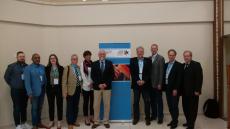The Physical Activity Crisis in Children
Sport and physical activity are high on the international policy agenda, and documents, like UNESCO’s International Charter of Physical Education, Physical Activity and Sport, and recommendations for the EU’s Work Plan for Sport, show a growing awareness of the importance of active lifestyles, and research also shows the costs of inactivity!
Ironically, it seems that the more we learn about the benefits of physical activity, the less active Europeans seem to become! To underline this statement, the research of the PASS project – Physical Activity Serving Society - financed by the European Union, and undertaken by a group of European Universities and organisations, gave the following numbers:
- 210 million Europeans are physically inactive!
- This inactivity costs the EU around 80 billion Euro per year; and maybe even more surprisingly!
- Around 80% of the European Policy makers are not aware of this situation!
We know from research that childhood is the foundation for development and health in later life, and that intellectual, social, individual, emotional, and physical capital and consequently also the financial capital for a person’s life is developed during childhood. Research for Designed to Move, an initiative led by Nike, and scientifically supported by ICSSPE and the American College of Sport Medicine, shows that the first 10 years of life provide a critical window for creating a lifelong commitment to physical activity.
So, if we actually know about the importance of sport and physical activity, and especially in the first ten years, what can we do about the physical inactivity of children and youths?
Clearly, there are many different areas to work on, since the influences on physical activity behavior are manifold. It is obvious that many international and national recommendations and charters have been signed by many countries, but the translation into practice – namely down to the mentioned areas - rarely take place. And since it seems that more local level administration have a stronger impact on individuals than national policies have, those responsible for physical activity in communities and cities need to be involved into actions against physical inactivity. These actions could be clustered around areas of particular interest such as grassroots sports, cities and urban planning, health, education and industry.
But there are not only the mentioned different areas that need to be targeted, but also different age groups have different challenges that need to be looked at. And following the above-mentioned background, children and youth should be addressed. Summarizing it very shortly it can be said, that:
- The early years (birth to 10) crucially influence the life-long engagement in sport and physical activity. And, not to forget, this also applies for bad experiences conversely!
- Target groups for supporting activities have to include those who influence children: families, child-care facilities and schools, and supporting material needs to give assistance on quality, quantity and settings.
- In the early years, early specialisation in sport can be counterproductive. During this process, very young children are expected to focus on just one sport, and train with adult-like intensity. And despite an absence of real evidence that early specialisation is an effective method preparation of sporting success, it is still widely used.
So, positive movement experiences must be the cornerstone of Quality Physical Education and of Physical Activity and sport programmes before anything else.
This can and should be reached by conducting a multi-component approach to reach all pupils, such as offering a wider range of activities, especially for those who do not currently enjoy physical activity; quantitatively increasing the amount of time for physical activity – more physical education lessons as well as more active breaks; qualitatively improving the opportunities for physical activity, for example, by optimising the activity time during physical education lessons, since children often actively move less more than five minutes per lesson; improving the integration of physical activity into the curriculum of schools; creating a physical activity-friendly environment; and involving parents; which is also closely linked to promoting active transport on the way to school (e.g. “walking busses”).
There are many challenges that we face which influence the physical activity behaviour and they concern different areas, and none of them can fix the problem alone! So, cooperation between all concerned areas is inevitable!
Katrin Koenen, Director Scientific Affairs of ICSSPE, presented this topic during the 5th Bilateral Israeli - German Symposium of the Ministry of Culture and Sport, Israel and the Federal Ministry of the Interior, Building and Community, Germany in Nazareth, Israel, 23rd - 26th April 2018. The full article will be published in the proceedings in the near future.

